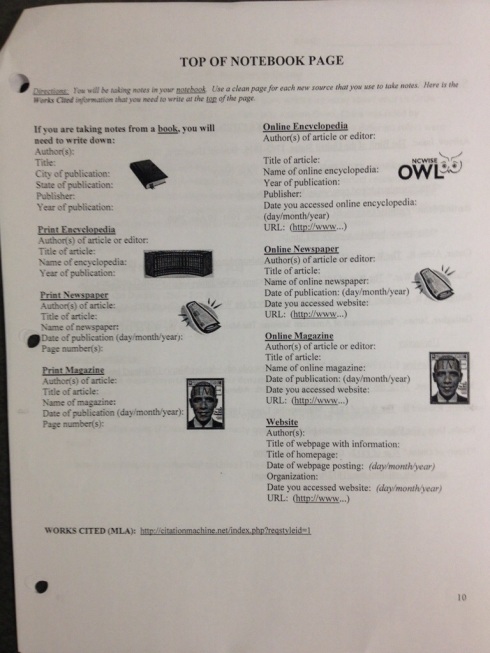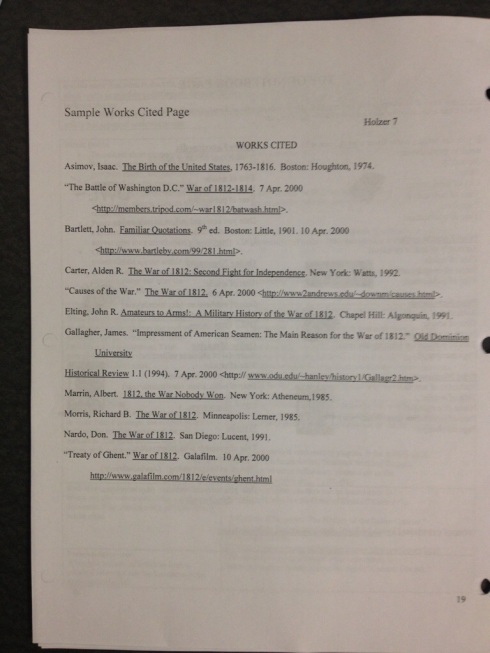Research Essay: Example Outline
23 AprHOW TO WRITE AN OUTLINE
An outline breaks down the parts of your thesis in a clear, hierarchical manner. Most students find that writing an outline before writing the paper is most helpful in organizing one’s thoughts. If your outline is good, your paper should be easy to write. The basic format for an outline uses an alternating series of numbers and letters, indented accordingly, to indicate levels of importance. Here is an example of an outline.
I.INTRODUCTION
A. HOOK/ ANECDOTE/ QUESTION/ QUOTE / STATEMENT
B. BACKGROUND INFORMATION
C. ARGUMENTS FOR/ARGUMENTS AGAINST
D. THESIS STATEMENT (INCLUDES BOTH ARGUMENTS)
II.PRO (FOR/GOOD REASONS/POSITIVE)
A.
1.
2.
B.
1.
2.
C.
1.
2.
III. CON (AGAINST/BAD REASONS/NEGATIVE)
A.
1.
2.
B.
1.
2.
C.
1.
2.
IV. YOUR POSITION
A.
1.
2.
B.
1.
2.
V. CONCLUSION
VI. WORKS CITED
Research Essay: Thesis Statements
23 AprSome defining features of a thesis:
For most student work, it’s a
one- or two- sentence statement that explicitly outlines the purpose or point of your paper. A thesis statement is to a paper what a topic sentence is to a paragraph.
It should point toward the
development or course of argument the reader can expect your argument to take.
Because the rest of the paper will support or back up your thesis, a thesis is normally placed at or near the
end of the introductory paragraph.
It is an
assertion that a reasonable person could disagree with if you only gave a thesis and no other evidence. It is not a fact or casual observation; it must beg to be proved. And someone should be able to theoretically argue against it (how successfully will depend, of course, on how persuasive you are.)
It
takes a side on a topic rather than simply announcing that the paper is about a topic (the title should have already told your reader your topic.)
Don’t tell your reader
about something; tell them what about something. Answer the question “how?” or “why?”
It is sufficiently
narrow and specific.
It argues
one main point and doesn’t squeeze three different theses for three different papers into one sentence.
Most importantly,
it passes the “So What? Test” – What does it matter? Why should I read your paper?
Your turn: Choose the best working thesis for the proposed research papers
. Research Paper 1: Thesis A: Business practices in former Soviet Union countries. Thesis B: Business practices in the countries of the former Soviet Union have changed drastically since the break-up. Thesis C: Since the break-up of the former Soviet Union, business practices in those countries have changed most in the fields of marketing and customer service, reflecting the changes in government and political philosophy. Research Paper 2: Thesis A: Shakespeare intended the audience to question the existence of Hamlet’s father’s ghost. Thesis B: The appearance of Hamlet’s father’s ghost raises an important psychological as well as dramatic dilemma in the play. Thesis C: Critics through the ages have debated the significance of Hamlet’s father’s ghost.
Research Essay: Plagarism
23 Apr
| KEEP FROM PLAGIARIZING
Action during the writing process: |
Appearance on the finished product: | ||
| When researching, note-taking, and interviewing. | Mark
everything that is someone else’s words with big quotation marks.Indicate in your notes which ideas are taken from sources (S) and which are your own insights (ME). Record all of the relevant documentation information in your notes. |
Proofread and check your notes to make sure that anything taken from your notes is acknowledged in some combination of the ways listed below:In-text citation Bibliography Quotation marks Indirect quotations |
|
| When paraphrasing and summarizing. | First, write your paraphrase and summary without looking at the original text, so you rely on your memory.
Next, check your version with the original for content, accuracy, and mistakenly borrowed phrases. |
Begin your summary with a statement giving credit to the source. According to Jonathon Kozol,… Put any unique phrases or words that you cannot change, or do not want to change, in quotation marks: …found that “savage inequalities” exist throughout our educational system (Kozol). |
|
| When quoting directly. | Keep the person’s name near the quote in your notes and in your paper.
Select those direct quotes that make the most impact in your paper-too many direct quotes may lessen your credibility and interfere with your style. |
Mention the person’s name either at the beginning of the quote, in the middle, or at the end. Put quotation marks around the text that you are quoting. Indicate added phrases in brackets ([ ]) and omitted text with ellipses (…). |
|
| When quoting indirectly. | Keep the person’s name near the text in your notes and in your paper.
Rewrite the key ideas using different words and sentence structures than the original text. |
Mention the person’s name either at the beginning, in the middle, or at the end of the information. Double check to make sure that your words and sentence structures are different than the original text. |
|
Research Essay: Internet Research Chart
23 AprAuthor:
Title:
Web address:
Copyright date:
Date found:
Source:
Copyright 2006 IRA/NCTE. All rights reserved.ReadWriteThink materials may be reproduced for educational purposes.
Research Essay: Note-Taking
23 AprEffective Note Taking:
Do not record material unrelated to your topic.
Make sure that summaries and paraphrases accurately express the ideas in your sources.
Be accurate.
Make sure to copy direct quotations word for word, with capitalization, spelling and punctuation precisely as in the original.
Make sure that every direct quotation begins and ends with quotation marks.
Double check statistics and facts for accuracy.
Distinguish between fact and opinion by labeling opinions as such:
o Dr. Graves thinks that…
o According to Grace Jackson…
Quote only the important parts of a passage.
Indicate words left out by using points of ellipsis (…)- a series of three spaced dots enclosed in brackets.
Use only the three dots when cutting material within a sentence.
Use a period before the dots when cutting a full sentence, a paragraph, or more than a paragraph. Use a period after the dots when you cut material from the end of a sentence.
Use brackets ([ ]) to enclose any explanatory information that you add within a quotation.
When to Quote, Paraphrase, and Summarize:
Direct quotation: Use a direct quotation when an idea is especially well-stated in a source-that is, when a passage is very clear, beautiful, funny, or powerful. Use direct quotation when the wording is historically or legally significant or when reproducing a definition.
Paraphrase: Use paraphrase as your basic note form. Paraphrase unless you have a good reason to quote or summarize your source.
Summarize: Summarize when a passage is too long to be quoted or paraphrased.
Quotation plus summary or paraphrase: Use this kind of note when you want to quote a source but need to give more explanation to make the quote.
EXAMPLES OF PARAPHRASING
Original Text (From a definition of color blindness)
visual defect resulting in the inability to distinguish colors. About 8% of men and 0.5% of women experience some difficulty in color perception. Color blindness is usually an inherited sex-linked characteristic, transmitted through, but recessive in, females. Acquired color blindness results from certain degenerative diseases of the eyes. Most of those with defective color vision are only partially color-blind to red and green, i.e., they have a limited ability to distinguish reddish and greenish shades. Those who are completely color-blind to red and green see both colors as a shade of yellow. Completely color-blind individuals can recognize only black, white, and shades of gray. (Columbia Encyclopedia, 6th ed.)
Paraphrase : Color blindness, affecting approximately 8% of men and .5% of women, is a condition characterized by difficulty in telling one color from another, most often hereditary but in some cases caused by disease. The majority of color-blind people cannot distinguish some shades of red and green, but those who cannot perceive those colors at all see red and green objects as yellow. There are people who cannot see color at all and perceive all objects in a range of black through gray to white. (Columbia Encyclopedia, 6th ed.)
Summary : Color blindness, usually a sex-linked hereditary condition found more often in men than women and sometimes the result of eye disease, involves limited ability to tell red from green, and sometimes complete inability to see red and green. In a much rarer form of color blindness, the individual sees no colors at all.
Quotation, Integrated : Color blindness is a “visual defect resulting in the inability to distinguish colors” (Columbia Encyclopedia, 6th ed.). Most often it is a hereditary condition that involves only some shades of red and green, but people with complete red-green color blindness see yellow instead, and some people have no color perception at all. (Columbia Encyclopedia, 6th ed.).
Research Essay: Literature Review
23 AprFind five articles about your topic and list the relevant facts from each one.
1. According to (author/source) (date ) the main idea about this subject is ______________________________________________________________________________________
List facts from the source that support this idea
1. fact_______________________________________________________________________________
2. fact_______________________________________________________________________________
3. fact_______________________________________________________________________________
4. fact_______________________________________________________________________________
5. fact_______________________________________________________________________________
(You can add more facts as you find them.)
In conclusion_______________________________ says______________________________________
___________________________________________________ about the topic.
2. Another idea, by (author/source) (date ) is_________________________
1. fact_______________________________________________________________________________
2. fact_______________________________________________________________________________
3. fact_______________________________________________________________________________
4. fact_______________________________________________________________________________
5. fact_______________________________________________________________________________
(You can add more facts as you find them.)
In conclusion_______________________________ says______________________________________
3. A third writer, ______________________________ (date ) states that ________________
1. fact_______________________________________________________________________________
2. fact_______________________________________________________________________________
3. fact_______________________________________________________________________________
4. fact_______________________________________________________________________________
5. fact_______________________________________________________________________________
(You can add more facts as you find them.)
The third author concludes that_________________________________________________________
4. A fourth source, ______________________________ (date ) states that ______________
1. fact_______________________________________________________________________________
2. fact_______________________________________________________________________________
3. fact_______________________________________________________________________________
4. fact_______________________________________________________________________________
5. fact_______________________________________________________________________________
(You can add more facts as you find them.)
This author concludes that______________________________________________________________
5. Yet another idea, from ______________________________ (date ) is that ____________
1. fact_______________________________________________________________________________
2. fact_______________________________________________________________________________
3. fact_______________________________________________________________________________
4. fact_______________________________________________________________________________
5. fact_______________________________________________________________________________
(You can add more facts as you find them.)
This author concludes that______________________________________________________________
Ancient China Dynasties: Research Essays
23 AprANCIENT CHINA DYNASTIES: Research Essay
Now that you are experts in the Middle Ages and have written an essay about your Lit Circle books we are moving out of the Middle Ages and into Ancient China. China was ruled by different rulers throughout its development, we call these periods where different rulers were in power Dynasties.
Using your new found essay writing skills you are tasked with researching a specific Ancient Chinese Dynasty and writing a research essay. We will have time to conduct research in the Library Lab – and you will be using a research outline to keep track of your different sources. Your final (2 to 5 page typed) essay must include information “quoted” from at least 4 different sources. We will go over in class how to integrate quotes and cite references.
The Dynasties:
1) The Shang Dynasty (1650 – 1027 BCE)
2) The Zhou Dynasty (1027 – 256 BCE)
3) The Qin Dynasty (256 – 202 BCE)
4) The Han Dynasty (206 – 220 CE)
5) The Sui Dynasty (589 – 618 CE)
6) The Tang Dynasty (618 – 907 CE)
Inquiry Questions:
~ Who are the major players/figures in this dynasty? What did they do, and why was it important?
~ What is the major accomplishment of this dynasty? Why is this so important?
~ Where: What areas of China did this dynasty control? and did it expand/decrease during its reign?
~ Why is this dynasty so influential to China? The modern world?




